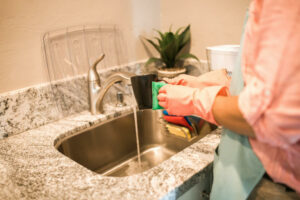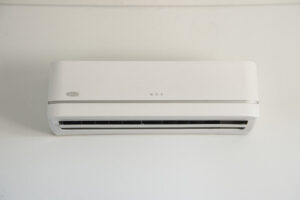
The appropriate way to clean a shower should be common knowledge in every home. Because taking a shower in a filthy shower does not contribute to having a good start to the day and is not especially hygienic either. If you’ve been scrubbing like crazy, but the limescale and mold are still present, you need the expert advice that we’re going to give you in order to get rid of them for good.
One of the most important aspects of understanding how to clean a bathroom, regardless of whether you want to clean the shower with vinegar and baking soda or with more powerful household cleaners, and despite the fact that it is not as time-consuming or difficult of a task as it may appear.
The most significant difficulties that you can encounter are water stains, smeared tiles, and moldy grout; we will assist you in resolving these issues, as well as a slow drainage and a blocked shower head, both of which can quickly detract from the quality of your showering experience.
Clean Out Your Bathroom Shower
It will be a lot simpler for you to clean your shower if there is nothing in it when you start. Take out everything that’s stuck in your shower drain, including any hair and debris, as well as shampoo bottles, razor blades, and other similar items.
Clean the Shower Basket
Scrub the surface of your shower basket with a scourer after applying an all-purpose bathroom cleaner to it using a spray bottle. After rinsing with warm water, dry the surface with a cloth made of soft microfiber or a paper towel. In regions with hard water, using a limescale remover once a week is recommended.
To get a clean shower at home with no effort and expense, you can make use of citric acid, which is an underappreciated but highly powerful cleaning ingredient. When you use it, you should wear gloves to prevent skin irritation, but otherwise, all you have to do is combine a half cup of powdered citric acid of food grade with a warm bucket of water, and then use it to clean it all in your shower, including the tiles, the toilets, the shower heads, etc. It is just as good at removing limescale as it is soap scum.
After speaking with the professionals at the environmentally responsible cleaning company Bio-D (opens in a new tab), we learned that they suggest the following method for descaling your shower: “If a section of your shower is tiled, always wet your tiles with cold water. Then spray on your descaler, rub down gently with a soft toothbrush, and wash properly afterwards.” Apply descaler to your shower screen, wipe it down with a gentle cloth, and then use a squeegee after you rinse the area to remove any marks that may have been left behind.
Combat Any Gunk With Vinegar
When it comes to green cleaning, nothing beats the effectiveness of using white vinegar to restore the shine to your shower. Spray any gunk with a solution made of half water and half vinegar that has been mixed in an old spray bottle. After applying the solution, wait 15 minutes. Depending on the severity of the issue, you might have to use the more abrasive side of a scrubbing pad that does not scratch and put some effort into fixing it. After rinsing, dry with a soft cloth and then repeat if necessary.
Wash the Sealant Between the Shower Tiles
If there is any mildew present in the tile grout, you can clean it by filling an unfilled sprayer with a mixture of white vinegar and water in equal parts. Spray the entire area thoroughly with the solution, and then wait for it to seep in for five minutes. Use an old toothbrush or a grouting brush, and move it back and forth over the grout that is damaged. To finish, rinse with some warm water.
After that, create a paste by combining two teaspoons of bicarbonate of soda with a few dashes of water in a small bowl. Use a toothbrush or a grouting brush to apply the paste by dipping it in the mixture and working it into the grouting. Spray the surface with the vinegar and water mixture that you have prepared. Baking soda will begin to foam as a result of the vinegar, which will also kickstart the removal process of any mold or soap scum. Use the brush to remove any buildup from the grout lines, and then rinse the area with some warm water.
This method is suitable for cleaning ceramic tiles; however, if your bathroom is tiled with marble, you should not use vinegar and instead look for additional instructions on how to clean tiles properly.
The Shower Nozzle
It’s likely that the openings in your shower head are blocked up if the water flow isn’t as strong as it once was or if it seems like water is spraying out in all directions when you turn on the shower.
Using a toothbrush to swiftly scrub away any dried debris that may have accumulated around the shower head’s openings is one method for effectively cleaning a shower head. You’ll need about a half pint of the solution that you make by combining white vinegar and water in equal parts, and then pouring that into a plastic bag.
Wrap the plastic carrier bag all around shower head in such a way that the holes are completely covered by the liquid. Put the bag in a safe place by securing it with a cable tie or an elastic band. Allow the ingredients to rest for at least 20 minutes, but leaving them overnight will produce the greatest results. Remove the bag from the shower, use a scrubbing brush to remove any loose sediment, and then turn the shower to its hottest setting to flush the holes. If your shower head is still blocked after trying the steps above, we would recommend calling a plumber to look into it.
Shower Doors Are the Worst!
It is recommended that you clean your shower door on a regular basis rather than giving it an occasional thorough cleaning. After each shower, spritz the area with an environmentally friendly cleaner and wipe it down with a fresh towel. You should invest in a low-cost squeegee for the shower and make it a habit to always use it. The few seconds it takes you to accomplish this will greatly reduce the quantity of dirt and grime build up.
Use a mixture of bicarbonate of soda and water to remove dirt that is particularly tenacious. To begin started, take 8 tablespoons of bicarbonate of soda and add sufficient water to it so that it can be mixed into a paste. Scrub the glass using a sponge that does not contain abrasives. To rinse, use a spray bottle filled with a mixture of water and white vinegar that is equal parts each. Use your squeegee or some paper towels to dry the area.
Wash Your Shower Curtain
If you have a shower curtain, you can remove unsightly mold stains from it by tossing it into the washing machine with a few old towels along with the curtain. To the load, add one-fourth of a pint of your regular washing liquid and one-fourth of a pint of bicarbonate of soda. Rinse it in warm water using the standard cycle on your washing machine. During the rinsing process, pour in a quarter of a pint of white vinegar. Let it drip dry, don’t put it in the tumble dryer.
Find out how to wash your shower curtain effectively, and if you want to avoid mold growth in the first place, make it a habit to frequently immerse your shower curtain in a salt water bath for a couple hours, then allow it to dry completely before rehanging it. This is a chemical-free way to prevent mold from growing on your shower curtain.
Unclog and Maintain Your Shower Drain
It is not a nice experience to have to stand in filthy water that is lukewarm because the drain in your shower has quit functioning properly. In point of fact, a shower that drains well is always considered to be clean. The most common cause of a clog is hair, and fortunately, there is an easy solution to this problem.
In a last-ditch effort, you can pull any clumps of hair out of the drain by unwinding a metal coat hanger and sliding one end of it inside the drain. Use a device that is specifically meant to remove hair from drains, such as a drain snake, or try a gel drain unblocker. An even better option is to use a device that is particularly designed to remove hair from drains.
Pour one-fourth of a pint of bicarbonate of soda down the drain, then one-fourth of a pint of white vinegar, and finally cover the drain with a moist cloth to ensure a complete cleaning. Let it boil for ten minutes. After removing the cloth, flush the drain with water that has been brought to a boil in a separate container.



